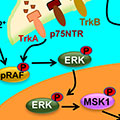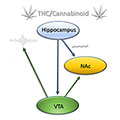Featured Paper of the Month – October 2018
Published in Molecular Psychiatry by Lee, Mary R; Tapocik, Jenica D; Ghareeb, Mwlod; Schwandt, Melanie L; Dias, Alexandra A; Le, April N; Cobbina, Enoch; Farinelli, Lisa A; Bouhlal, Sofia; Farokhnia, Mehdi; Heilig, Markus; Akhlaghi, Fatemeh; Leggio, Lorenzo
Understanding the neurobiological substrates of excessive alcohol consumption may substantially facilitate efforts to develop better treatments. The cross-talk between the gastrointestinal and central nervous systems, often referred to as the gut–brain axis, is a promising yet underexplored domain in this regard. Ghrelin is a hormone primarily produced by the stomach and known for its role in increasing appetite and food intake (the “hunger hormone”). Recent animal and human studies suggest that ghrelin may also be involved in alcohol-seeking behaviors. In rodent experiments, blocking the ghrelin receptor suppresses alcohol seeking and consumption…










